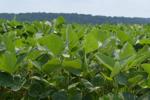According to many sources, potato leafhopper has arrived in the state. Extension entomologist John Tooker suggests growers would be wise to keep an eye out for increasing populations of this pest.
Once damage from their feeding is evident, economic damage has been done.
Potato leafhoppers are perennially the most damaging pest of alfalfa in Pennsylvania, but they can also cause economic damage in other legume forages and some vegetable crops.
Their feeding reduces yield and quality (especially lowering protein content), and can decrease stand longevity.
Potato leafhoppers do not live in Pennsylvania all year. They migrate here each spring on storm fronts, arriving in late May and early June.
Potato leafhoppers can be frustrating due to the sporadic nature of their infestations. Even in bad leafhopper years, many fields escape damage.
Once potato leafhoppers colonize alfalfa fields, adults deposit eggs into stems and leaf veins. In warm weather, these eggs will develop into adults in about three weeks, so populations can increase quickly.
Potato leafhoppers have straw-like mouthparts and extract plant juices. Heavy feeding disrupts nutrient flow within plants, causing yellow triangles to form at the leaflet tips (“hopper burn”), but this evidence of damage does not develop until seven to 10 days after feeding begins.
As feeding continues, damage gets worse, and the pale areas spread toward the base of the leaflet. Once hopper burn is evident, economic loss has occurred.
Managing Leafhoppers
For nonchemical control, resistant varieties of alfalfa are valuable. These varieties are covered with fine hairs (the hairs are actually “glandular trichomes”) that decrease leafhopper feeding, but obviously this option needs to be pursued before establishment.
Another option is to mix other forages in with alfalfa. Alfalfa-orchardgrass stands (or other combinations) appear much better at tolerating leafhopper damage than pure stands of alfalfa.
Spiders and other natural enemies kill potato leafhoppers, so using integrated pest management and spraying insecticides only when economic populations develop will help maintain these allies in pest control.
In fact, we have growers in Pennsylvania who do not treat their alfalfa fields with insecticides and claim they do not see potato leafhopper damage; natural enemies would be the best explanation for this lack of damage.
If damaging populations develop, early harvest or insecticides are often the only choices. Early harvest can stop damage, but regrowth should also be scouted to determine if the next cutting also develops damaging populations.
To target leafhoppers most effectively, populations should be sampled and treatment applied only when economic thresholds are exceeded.
Regular scouting and use of economic thresholds can limit the need for insecticides to once a summer. Scouting details and economic thresholds can be found in our potato leafhopper fact sheet: bit.ly/PSUleafhopper
June 15, 2021 at 06:25PM
https://ift.tt/3wxBeve
Scouting Alfalfa Fields for Potato Leafhopper | Latest News for Corn, Soybeans, Wheat and more | lancasterfarming.com - Lancaster Farming
https://ift.tt/2rh4zOj
Potato


No comments:
Post a Comment